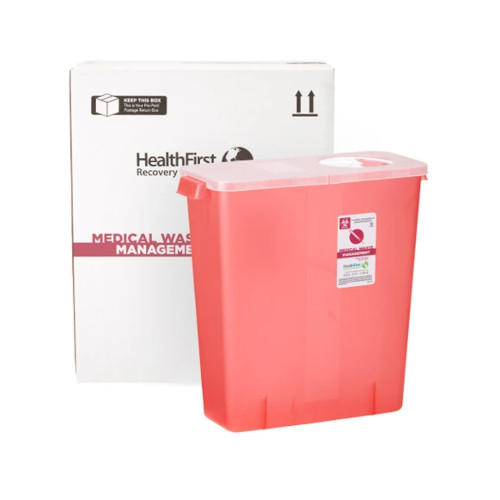Recognizing the Different Types of Garbage Disposal Strategies
In the world of waste monitoring, the array of disposal techniques offered today is huge and differed, each approach serving an unique objective in addressing the challenge of waste disposal. click here. From reusing approaches that aim to provide brand-new life to products, to the intricate processes of harmful waste monitoring, the landscape of waste disposal is intricate yet crucial for environmental sustainability. Comprehending the nuances of these different methods not just clarifies the significance of accountable waste administration yet additionally motivates us to reassess our technique in the direction of garbage disposal in a swiftly advancing world

Recycling Techniques
Reusing techniques are essential for sustainable waste management methods in both domestic and industrial settings. medical waste disposal. By applying reliable recycling strategies, a significant amount of waste can be drawn away from landfills, preserving all-natural sources and decreasing the ecological effect of production processes
In suburbs, curbside recycling programs play a crucial role in encouraging families to different recyclable materials from basic waste. Materials such as paper, plastics, glass, and steels can be sorted and gathered for handling right into brand-new items, decreasing the demand for basic materials and energy-intensive manufacturing processes.
Industrial centers also count on reusing techniques to reduce waste generation and promote a circular economic situation. By executing closed-loop systems, services can recycle products within their production procedures, reducing costs and ecological impact. medical waste removal near me. In addition, commercial recycling programs commonly entail partnerships with specialized recycling facilities to make sure that products are effectively arranged, refined, and rehabilitated into the supply chain
Composting Techniques

Aerated static heap composting includes mixing organic waste products in a big stack and on a regular basis turning it to make certain appropriate oygenation. This method is reliable for large-scale composting operations. On the various other hand, vermicomposting uses earthworms to damage down natural issue right into nutrient-rich castings. This technique is fit for smaller-scale procedures and families.
In-vessel composting includes positioning organic waste in a shut container with controlled conditions for temperature level and aeration. This technique is reliable for managing food waste in metropolitan areas. Finally, windrow composting consists of forming long rows of organic waste and consistently turning them to promote disintegration. This strategy is generally made use of in farming setups.
Landfill Disposal
Land fill disposal is a frequently utilized technique for taking care of waste that can not be recycled or composted. It involves burying waste in assigned areas of land, with proper preventative measures to stop ecological contamination. Landfills are engineered centers designed to isolate waste from the surrounding atmosphere. The waste is compressed and covered with dirt everyday to lower smells, discourage bugs, and decrease the spread of litter. Modern land fills are geared up with safety linings and keeping track of systems to avoid leak of unsafe compounds right into the soil and groundwater. Methane gas, a result of decomposing organic waste in garbage dumps, is commonly collected and utilized as a source of sustainable power. Regardless of innovations in landfill technology, issues continue to be concerning the long-term environmental impacts, such as groundwater contamination and greenhouse gas emissions. Efforts to reduce dependence on land fills consist of advertising waste decrease, recycling, and checking out alternate waste disposal methods to minimize the environmental footprint connected with traditional landfill disposal practices.

Waste-to-Energy Incineration
Incineration of waste for energy generation is an approach increasingly being thought about as a choice to conventional land fill disposal techniques. Waste-to-energy incineration includes the burning of waste products at heats, usually in specialized centers designed to create electrical power or warmth with the procedure - click here. This strategy not just minimizes the quantity of waste that would certainly otherwise be destined for garbage dumps however also uses the warmth created during incineration to create power
One of the essential benefits of waste-to-energy incineration is its capability to produce power while reducing the ecological impact compared to traditional landfill disposal approaches. By transforming waste right into energy, this approach assists in decreasing greenhouse gas discharges and reliance on fossil fuels for power generation. Furthermore, waste-to-energy centers are equipped with advanced air pollution control innovations to minimize potential environmental toxins launched throughout the combustion procedure.
Contaminated Materials Administration

Considering the crucial significance of responsible waste monitoring techniques, specifically in the world of environmental sustainability, the focus currently changes in the direction of the elaborate domain of Contaminated materials Administration. Hazardous waste poses substantial dangers to both human health and wellness and the environment, demanding specific handling and disposal methods. Typical examples of unsafe waste consist of chemicals, batteries, pesticides, and digital waste.
Contaminated materials Management entails the recognition, collection, transportation, treatment, and disposal of products deemed harmful or possibly hazardous. This process requires adherence to rigorous regulations and guidelines to reduce negative effect on environments and public health and wellness. Different approaches are utilized in managing contaminated materials, consisting of recycling, protected landfills, encapsulation, and chemical therapy.
Appropriate Contaminated Materials Administration is crucial for protecting against contamination of dirt, water resources, and air pollution. It is essential for sectors, labs, healthcare facilities, and other generators of contaminated materials to carry out durable monitoring strategies, More hints training programs, and emergency reaction prepares to ensure the risk-free handling and disposal of these materials. Failing to take care of contaminated materials suitably can have far-reaching consequences, underscoring the significance of attentive and liable techniques in this field.
Conclusion
In final thought, waste disposal strategies play a critical duty in managing and reducing the impact of waste on the environment. It is crucial for markets and people to comprehend the different waste disposal strategies available and pick the most ideal technique for sustainable waste monitoring.
In the realm of waste management, the variety of disposal methods offered today is substantial and differed, each method serving an unique objective in attending to the challenge of waste disposal. click here. From recycling methods that intend to offer new life to materials, to the intricate procedures of harmful waste management, the landscape of waste disposal is complex yet important for environmental sustainability. Comprehending the nuances of these various techniques not only sheds light on the significance of accountable waste administration yet additionally prompts us to rethink our strategy in the direction of waste disposal in a quickly evolving globe
Efforts to reduce dependence on landfills consist of promoting waste decrease, recycling, and discovering alternate waste disposal techniques to minimize the environmental footprint connected with standard landfill disposal methods.
It is important for sectors and individuals to recognize the different waste disposal strategies available and select the most appropriate technique for lasting waste administration.